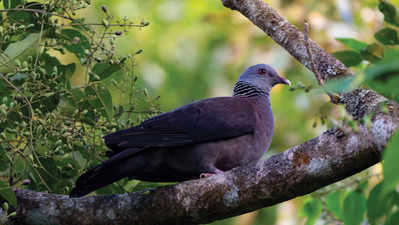Trending
56 bird species from Western Ghats and Goa face global conservation threats
Panaji: A total of 56 bird species in Goa are facing global conservation threats due to habitat loss, climate change and human activities. These 56 species are globally classified as critically endangered (4 species), endangered (5), vulnerable (15) and near threatened (31). While some of these 56 birds are rarities to the state, others are endemic to Western Ghats and Goa.
“The critically endangered birds include lesser florican, white-rumped vulture, Indian vulture and yellow-breasted bunting all of which are rarities,” Pronoy Baidya, who co-authored ‘Threatened Birds of Goa’, told TOI.
“Vultures were quite common at some point in the past, with several large congregations observed from Goa Meat Complex, Usgao till 2002-2004. However today we rarely see one of any species,” Baidya said.
“This decline globally was because of impacts of diclofenac, a nonsteroidal anti-inflammatory drug (NSAID) which was widely administered to livestock and subsequently found to be lethal to vultures that consumed contaminated carcasses. The white-rumped vulture and Indian vulture both declined by more than 90%,” Baidya said.
The findings reveal that out of the five endangered species, the Great knot, which is sighted in Goa, breeds across the north-east of Siberia, with records from Alaska while migrating to Australia, south-east Asia, India, and extending into Arabia.
“Loss of resting sites while migrating and wintering habitats due to land use change, that includes dredging of mudflats, large coastal harbour projects, disturbance from coastal tourism and attacks by feral dogs on beaches are the greatest threats, many of which are relevant to Goa too,” Baidya said.
Endemic species like the Nilgiri wood-pigeon, river tern and Malabar grey hornbill, crucial for ecosystem health, are facing significant declines due to habitat loss caused by deforestation and development projects.
“Historically, sites like the Verna plateau, where regularly visited by Nilgiri wood-pigeon for its fruit bearing trees and shrubs. At present, they are completely degraded as several trees that would host this species during winter for foraging have been cut for road widening projects. River Tern is another species that is known to breed in large numbers with the reservoir Islands of the state’s Western Ghats. They face threats from accidental ingestion of chemicals and microplastics through fish and lose of breeding habitats,” said co-author Jalmesh Karapurkar.
‘Threatened Birds of Goa’ was launched at the 8th Bird Festival of Goa, and was co-authored by Baidya and Karapurkar from Arannya Environment Research Organisation (AERO) and Sujeetkumar Dongre from the Centre for Environment Education (CEE).
They stressed the need for more research on these bird species in Goa, including their habitat preferences, food habits, and migration patterns. They recommend a multi-pronged approach to conservation, including habitat protection, species-specific conservation plans, and public awareness programmes.
“There are several identified knowledge gaps when it comes to initiating conservation action for birds. We lack information about their habitat preferences for breeding and wintering locally, besides their food preferences and relationship with flowering and fruiting patterns of associated plants. For migratory birds we still do not understand fine scale movement with respect to their arrival and departure patterns,” said Dongre.
End of Article
FOLLOW US ON SOCIAL MEDIA
Visual Stories
Hot Picks
TOP TRENDING
Explore Every Corner
Across The Globe











